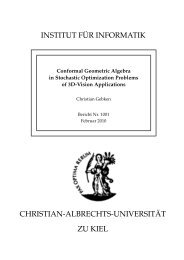Curry: An Integrated Functional Logic Language
Curry: An Integrated Functional Logic Language
Curry: An Integrated Functional Logic Language
Create successful ePaper yourself
Turn your PDF publications into a flip-book with our unique Google optimized e-Paper software.
C.2 Layout<br />
Similarly to Haskell, a <strong>Curry</strong> programmer can use layout information to define the structure of<br />
blocks. For this purpose, we define the indentation of a symbol as the column number indicating<br />
the start of this symbol. The indentation of a line is the indentation of its first symbol. 15<br />
The layout (or “off-side”) rule applies to lists of syntactic entities after the keywords let, where,<br />
do, or of. In the subsequent context-free syntax (Section C.3), these lists are enclosed with curly<br />
brackets ({ }) and the single entities are separated by semicolons (;). Instead of using the curly<br />
brackets and semicolons of the context-free syntax, a <strong>Curry</strong> programmer must specify these lists<br />
by indentation: the indentation of a list of syntactic entities after let, where, do, or of is the<br />
indentation of the next symbol following the let, where, do, of. <strong>An</strong>y item of this list start with<br />
the same indentation as the list. Lines with only whitespaces or an indentation greater than the<br />
indentation of the list continue the item in its previous line. Lines with an indentation less than<br />
the indentation of the list terminates the entire list. Moreover, a list started by let is terminated<br />
by the keyword in. Thus, the sentence<br />
f x = h x where {g y = y+1 ; h z = (g z) * 2 }<br />
which is valid w.r.t. the context-free syntax, is written with the layout rules as<br />
or also as<br />
f x = h x<br />
where g y = y+1<br />
h z = (g z) * 2<br />
f x = h x where<br />
g y = y+1<br />
h z = (g z)<br />
* 2<br />
To avoid an indentation of top-level declarations, the keyword module and the end-of-file token are<br />
assumed to start in column 0.<br />
C.3 Context Free Syntax<br />
Module ::= module ModuleID [Exports] where Block<br />
ModuleID ::= see lexicon<br />
Exports ::= ( Export1 , . . . , Exportn )<br />
Export ::= QFunctionName<br />
| QTypeConstrID<br />
| QTypeConstrID (..)<br />
| module ModuleID<br />
Block ::= { [ImportDecl1 ; . . . ; ImportDecln ;] (n � 0) [FixityDeclaration1 ;<br />
. . . ; FixityDeclarationn ;] (n � 0) BlockDeclaration1 ; . . . ; BlockDeclarationm } (m � 0)<br />
ImportDecl ::= import [qualified] ModuleID [as ModuleID] [ImportRestr]<br />
15 In order to determine the exact column number, we assume a fixed-width font with tab stops at each 8th column.<br />
60
















